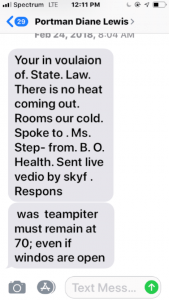I recently received a plat of survey from a client for a 90-year-old two-family residence he had purchased. (Survey obtained after the closing.) It showed several things:
- The building encroached 8′ onto his neighbor’s property;
- In addition, there was a walkway and retaining wall the projected even further onto his neighbor’s property; and
- The home projected 6′ into the public right-of-way (a “right-of-way” is the land owed in “fee simple” or by easement by a governmental entity for roadway and sidewalk purposes (such as through dedication); it is usually much wider than the actual paved area for either).
Now, that’s a hot mess of title and survey issues. What to do? What to do?
Get a survey before a purchase
Well, for starters, this is great example of why a buyer needs a survey in addition to a title examination before purchasing real property. None of these problems would be evidenced by a title examination. Only a field survey would show these encroachments. Further, title insurance does not cover these occurrences.
Excuses and justifications
As a side note, we hear over the phone and in the closing room the 25 reasons why a buyer, lender or Realtor does not think title insurance or a survey is needed:
- The property is “new” (i.e. a new subdivision, with newly-constructed houses);
- The property is “old,” meaning the homes, garages, driveways and other improvements have existed for a long time.
- Certainly the seller checked the title and survey, so it is fine.
None of these is a good reason not to get title insurance and a survey. We can explain further if you like.
Other survey nightmares
In addition to the problems identified above, we have seen other major survey problems:
- A new house built in violation of a zoning or covenant setback.
- An entire subdivision where each house was built 5′ onto the neighbor’s property (and thus needs re-platting, deeding the 5′ to the correct owner, a release of the “wrong” mortgage and a re-filing of the correct mortgage).
- Condominiums where the unit numbering was changed from the time the contract was signed to the time when the condominium documents were file (and thus many units were mis-numbered and every unit needs a new deed, a release of the “wrong” mortgage and a re-filing of the correct mortgage).
- A complete misunderstanding (or misrepresentation) of the location of property lines.
- Encroachments (e.g., fences, sheds, utilities) of various improvements onto our client’s property.
- Encroachments of various improvements from our client’s property onto their neighbor’s property.
- An easement that runs right where your client intends to build on otherwise “raw land.”
Solutions
For the client noted above, he has several remedies to the problems.
- First, did he purchase title insurance? If he did, he may have a claim — but probably not. Why not? For starters, title insurance provides coverage for the insured premises, not for property outside the boundaries of the insured premises. And by definition, the three problems he called about are outside of the metes and bounds of the property he acquired. Moreover, the standard title insurance policy specifically excepts coverage of matters that would be disclosed by an accurate survey, and as a rule that exception to coverage is not deleted (and thus coverage provided) without a survey certified to the title company.
- Second, did he get a general warranty deed from the seller, the most common form of deed in use in southwest Ohio certainly? If so, he may (may) have a claim against the seller for breach of the contract and breach of the general warranty covenants.
- Third, as to the first two issues (the encroachments onto the neighbor’s property he almost certainly has a strong case for a claim to ownership of the property through “adverse possession.” You may read a detailed analysis of that here.
- Fourth, however, as to the portion of the property in the public right-of-way, the client has a difficult row to hoe. One may not adversely possess against a governmental entity in Ohio. The only way to perfect title to the portion of the building in the right-of-way is to seek a deed (or statutory street vacation) from the governmental entity whereby they voluntarily surrender that title to the property owner.
Conclusion
The saying “an ounce of prevention is worth a pound of cure” is appropriate here, as it is with all due diligence investigations before the purchase of real property. The buyer should have “kicked the tires” with a good surveyor before closing on the sale. But this is the situation now. So, he can pursue the seller and the neighbor to vindicate his rights to the home and walkway. As to the governmental entity owning an interest in the right-of-way, he simply needs to work the ropes to see if it will relinquish its interest in his home.










